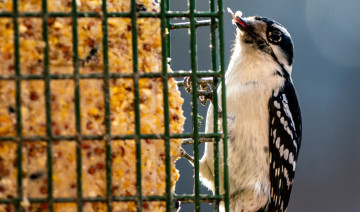
Suet for Birds
Suet is an ideal food for wild birds, rich in fat and calories to provide exceptional energy just when birds need it most as temperatures drop. But what exactly is suet, and how can it be offered to backyard birds?
About Suet
Suet is the rendered fat from cattle and sheep, generally fat found around the animals’ kidneys. Rendering is the process of melting, straining, and cooling the fat to remove leftover bits of tendon, cartilage, bone, and muscle, to create a pure product that will stay firm at higher temperatures.
Suet for birds is often mixed with birdseed, dried insects or mealworms, peanut hearts, or bits of dried fruit to add more nutrition and attract more bird species. Different flavorings may also be added to the suet, and ingredients such as flour or cornmeal can be used to create different textures that make the suet easier for birds to eat.
There are many different suet types and shapes available to feed wild birds. In addition to basic cakes, suet can be shaped into balls, plugs, or whimsical shapes such as wreaths, bells, or hearts. Suet may also be broken into crumbles, shreds, or nuggets for easier bird feeding, and softer suet may be marketed as doughs or butters.
Ready-made suet is easy to find anywhere bird feeders and birdseed may be sold, including nature centers, garden centers, wild bird stores, and big box retailers. Raw suet can also be bought from butcher shops for do-it-yourself birders who want to render and blend their own suet.
Birds That Eat Suet
Many different birds will nibble at suet, and just about any bird will at least try a taste. Birds that especially love suet and will return to suet feeders over and over, however, include:
- Bluebirds
- Chickadees
- Jays
- Nuthatches
- Orioles
- Starlings
- Titmice
- Woodpeckers
- Wrens
Even small backyard raptors, such as kestrels, sharp-shinned hawks, and Cooper’s hawks, will occasionally munch from a suet feeder.
Feeding Suet to Birds
Because suet is so popular, there are many great ways to offer it to backyard birds. Basic mesh feeders can hold a suet cake, or other suet feeders can hold different suet shapes. Small pieces can also be put into platform or tray feeders, and soft suet doughs and butters can be smeared on tree trunks, fences, or deck railings – but be aware that the oils in suet may stain wood.
Suet can be just as attractive to other backyard wildlife as it can be to birds, including raccoons, squirrels, and even bears. To safeguard suet and be sure birds can eat their fill, use sturdy baffles around the feeders, and only put out as much suet each day as birds can comfortably eat. If raiders are a frequent problem, choosing suet mixed with hot pepper flakes can help keep other wildlife at bay without bothering birds’ weaker taste buds.
Placing suet feeders near trees where suet-loving birds are more comfortable can more quickly attract hungry birds, and excess suet can be frozen until it is needed.
Offering Suet Year-Round
While suet is most popular to offer in winter when the fat and calories help birds survive extreme cold, this food can actually be great for birds all year round. During spring and fall, suet provides easily digestible energy to fuel migration, mating dances, and nest-building, especially in early spring or late fall when natural food sources may not be as abundant.
In summer, suet is a fast and easy food source for wild birds to satisfy the ravenous appetites of hungry hatchlings. Because suet can soften and melt more quickly on hotter days, however, summer suet feeders should be placed in the shade to keep cooler, and frozen suet can be added directly to feeders each morning for a fresh option. No-melt suet varieties that are more finely rendered and mixed with ingredients to keep them from softening excessively are also available.
No matter what season, suet is a great food for wild birds, and will nourish a diverse flock of feathered guests every backyard birder will enjoy.
